A Private Tour today in North Norfolk. We had a particular list of things we wanted to see, so we would be very focused about what we did and where we went. The weather gods looked favourably on us again – after very heavy rain and high winds overnight, it was much calmer by morning, dry but cloudy initially, and then the skies cleared and we had some gorgeous winter sunshine in the afternoon. Lovely!
As we drove west along the coast road, we noticed a large flock of geese feeding in a grassy field and pulled up in a layby next to it. White-fronted Goose was on the target list for the day, and this is a field they sometimes like to feed in. Sure enough, that is just what they were. We got out quietly and set up the scope behind the minibus so as not to risk disturbing them.
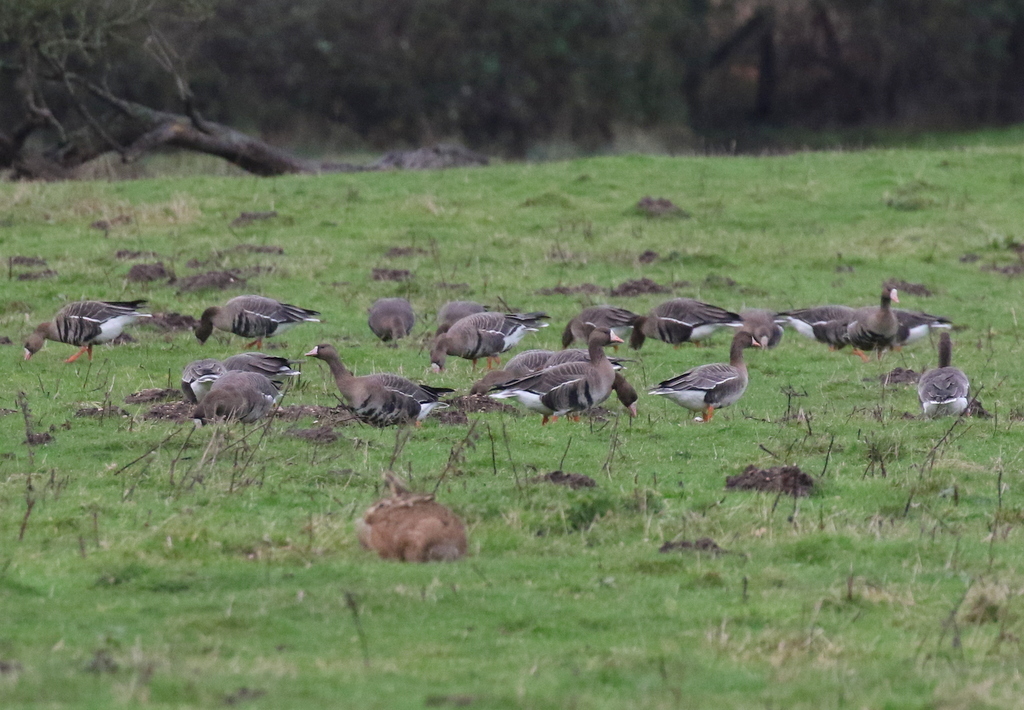
We could see the adult White-fronted Geese with the white surrounds to their bills and black belly bars like fingerprints. There were several plainer juveniles with them too. We counted 120 when we arrived, and several more small groups flew in to join them as we watched. By the time we left, there were at least 150 feeding on the grass. There were a few Egyptian Geese in the field too, plus a pair of Mistle Thrushes and a couple of Brown Hares.
Our next destination was Sedgeford, to look for the Eastern Yellow Wagtail. As we arrived, there were only a few cars today – the crowds have started to dissipate now it has been around for several weeks. We could see a couple of people further down the track, by its favoured muck heap, but they were looking round and it seemed pretty clear they were not looking at the bird. It often starts the day out in the field, so we stopped on the corner to scan.
A large flock of Fieldfares was feeding out in the middle of the field, accompanied by a mob of Starlings. A small covey of Red-legged Partridges was in the far corner and a mixed group of Linnets and Chaffinches landed on the edge of the cover strip along the edge. A Pied Wagtail flew in and landed down in front of us, but unfortunately had not brought its rarer cousin with it.
When a big flock of Meadow Pipits landed out in the field, we scanned across through them and there was the Eastern Yellow Wagtail with a couple more Pied Wagtails. We quickly got the scope on it and had a good look as it walked across between the furrows, before the flock took off and the wagtail disappeared.
The Pied Wagtails had flown off down the field, in the general direction of the muck heap, so we thought we would walk down the lane and see if the Eastern Yellow Wagtail had gone that way too. We hadn’t gone very far, and were just talking about its distinctive rasping call, when we heard it just behind the hedge. We called to some people who had just arrived and were still standing on the corner by the road, and by the time we got back to them they had found the Eastern Yellow Wagtail feeding along the edge of the field.

The Eastern Yellow Wagtail was a bit closer now, and more settled, feeding on its own. We had a much longer look at it through the scope, with its grey head, bright white supercilium and yellow underparts. It gradually worked its way further away from us before flying off down the field.
A steady stream of Pink-footed Geese had been landing in a field away to the south, in the distance, while we were looking for the wagtail. Now we turned our attention to those. They were a long way off, but through the scope we found a single White-fronted Goose with them. Then someone else found two Barnacle Geese too.
We were just working our way steadily through the rest of the flock when something spooked them. The Pink-footed Geese all took to the air. It was quite a sight – a flock of several thousand geese taking off. Half of them flew off, while the other half landed back down in the field, although some were out of sight now beyond a ridge. We couldn’t see anything else of interest with those that were still visible, so we decided to move on. As we were walking back to the minibus, something spook them again and all the geese took off once more.
The Woodcock at Titchwell has been performing outstandingly for a steady stream of admirers in recent days. While it was not specifically on the target list for the day, we couldn’t not call in as we were within easy reach. We walked straight round to Meadow Trail and found a small group already gathered, and eventually as people moved on we were able to get the scope on it. It wasn’t where we had seen it recently, but thankfully had only moved about three feet to the left! Stunning!

There were lots of other things we hoped to do today, so we elected not to go further out onto the reserve today – unfortunately, with days short at this time of year, we would not have enough time. We made our way back to the minibus, and turned back east along the coast road to Holkham.
As we drove up along Lady Anne’s Drive, we could see the grazing marshes were full of water after last night’s rain. There were loads of birds. Lots of ducks, mainly Wigeon and a few Teal. And lots of Black-headed Gulls and Common Gulls, presumably attracted by the prospect of worms forced up by the water. It is looking really good for wildlife here at the moment. We parked at the top and walked up towards the pines. A covey of Grey Partridges was very well camouflaged on the edge of the ditch, looking across the grass.
When we got out onto the edge of the saltmarsh, we could see that it was very wet today too, after a big high tide this morning. The Shorelarks have been very mobile and elusive at times this week, with their favoured cordon being wet at times. Shorelark was a particular target for the day, so we figured we may have to search them out. Rather than head towards the cordon first, we decided to try the opposite direction.
We walked round on the dry path along the edge of the dunes, and as we started to pick our way round the puddles and flooded channels on the path out across the saltmarsh we met two other birders coming back the other way. They confirmed what we had hoped – the Shorelarks were just ahead of us. When we got out to the middle, we could see them, feeding with about twenty Skylarks on the other side.
We followed the Shorelarks for a while, keeping a discrete distance so as not to disturb them. The Skylarks flew off, but the Shorelarks continued to pick their way round the edge of the saltmarsh. With patience, we had some great views of them, feeding on the small seedheads, chasing each other, stopping to stretch and preen.
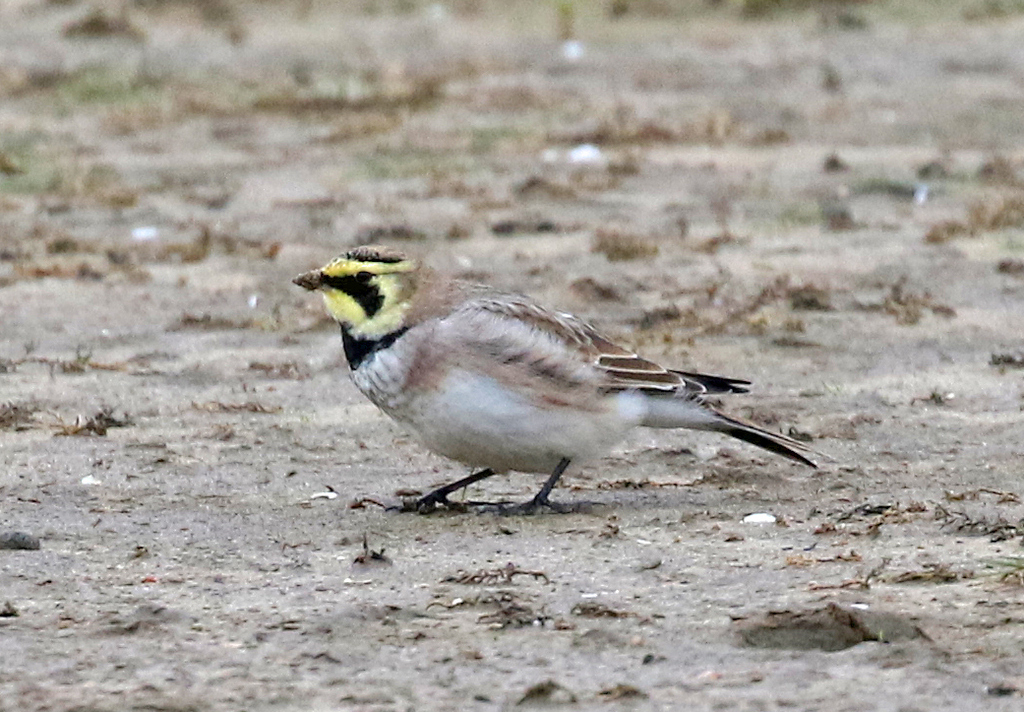
After enjoying our fill of the Shorelarks, we left them in peace. They could have been one of the hardest of today’s target species to find, so it was great to get them in the bag. Snow Bunting was the next one we wanted to find, and they have remained more faithful to the cordon area, despite the high tides, so we headed round there next.
A Rock Pipit flew across calling, a sharper call than a Meadow Pipit, and landed briefly on the saltmarsh, before flying off again. We flushed a small flock of Linnets ahead of us too. A small flock of Brent Geese was feeding out in the middle as we made our way east from the Gap, but they were up to their bellies in the vegetation and it was hard to see anything different in with them. Looking up to the sky, we could now see the trailing edge of the weather front approaching and blue sky beyond.
When we got to the cordon, we could see a large flock of Snow Buntings down at the far end, on the edge of the dunes. We couldn’t get out to the beach on the west side of the cordon, as there was still too much water in the channel, so we walked down to the east end and out that way. By the time we got down there, the Snow Buntings were now out in the middle of the cordon, so we had a quick look at them in the scope, before carrying on to the beach.
We could see several thousand Common Scoter in a couple of rafts out on the sea. Most of them were quite a long way out again today, too far to make out if there were any Velvet Scoters in with them. Another smaller group of Common Scoter closer in had just a single Great Crested Grebe with them. There were a few Red-breasted Mergansers on the sea too, including one drake quite close inshore. After a bit of scanning, we finally found a single Long-tailed Duck as well, another one we were hoping to find today. A couple of Red-throated Divers flew past, very distantly offshore. Five Pintail flying past out to sea were more of a surprise.
The sun came out now, and the Snow Buntings flew round behind us calling. We turned to see them land on the beach very close to us. They were rather skittish, and quickly took off again, flying round past us, before settling once more. We watched as they picked their way over the shells on the sand. They stopped in little groups and seemed to be arguing with each other. We hadn’t realised what they were doing until we got back and looked at the photos – they were drinking rainwater from small upturned cockle shells on the beach!
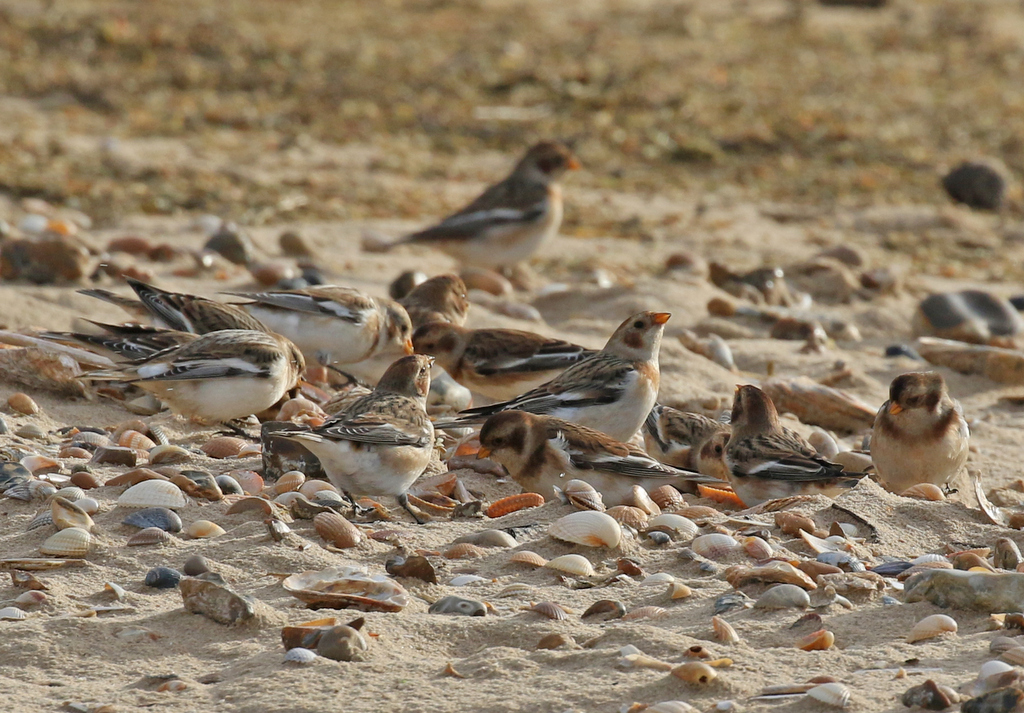
It was great watching the Snow Buntings in the sunshine, so when they flew off again and over our heads before disappearing off down the beach, we decided to head back. The flock of Brent Geese on the saltmarsh had now come a bit closer and we could pick out the Black Brant hybrid which is almost always with them – with a more obvious white flank patch and white collar than the others. A Short-eared Owl was hunting the dunes too, off in the distance.
After a quick stop to use the facilities in the Lookout, we walked back towards Lady Anne’s Drive. The Grey Partridges were now right on the corner of the grazing marsh, just below the path, so we stopped to admire them.

We stopped for lunch in the sunshine in the car park up at Holkham Park and afterwards walked in through the gates. There were a few Jays flying back and forth as we headed down towards the lake and a couple of groups of Fallow Deer in the trees.
When we got to the lake, we found plenty of Tufted Ducks and several Common Pochard. We walked down along the edge and quickly came across the Black-necked Grebe, which is what we had come primarily to see. We followed it for a while, as it dived continually, surfacing each time in a completely different place.
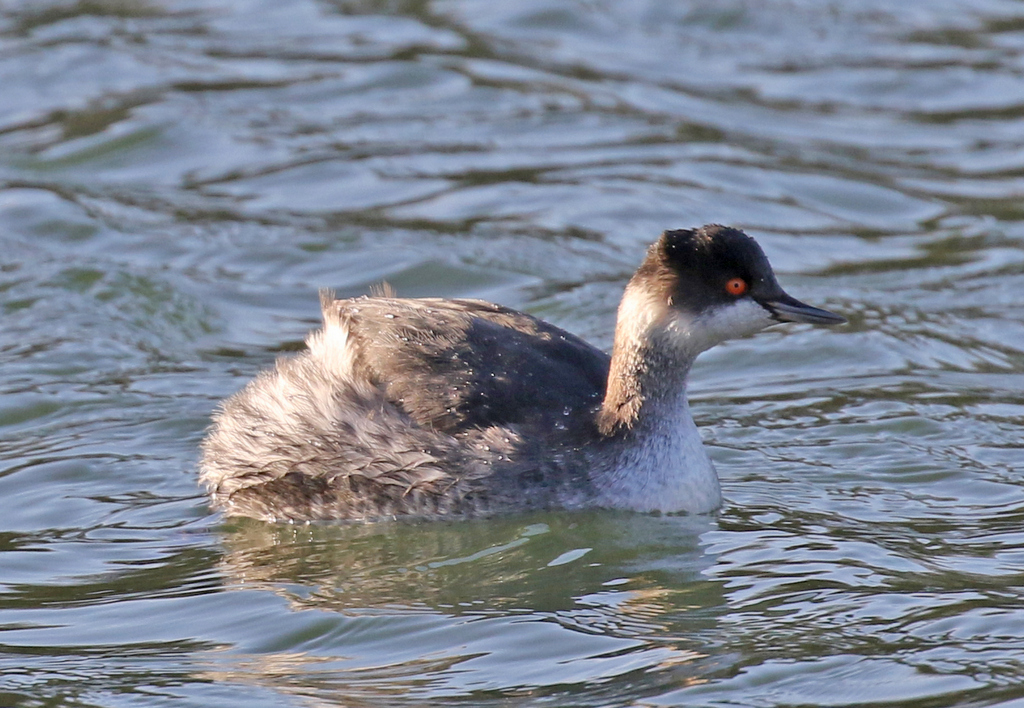
After watching the Black-necked Grebe for a while, we walked on down towards the hall, before turning and heading back towards the monument out across the open grass. There were lots of Fallow Deer feeding out on the grass, including quite a few grazing the outfield of the cricket pitch. They looked very smart in the low afternoon sun.
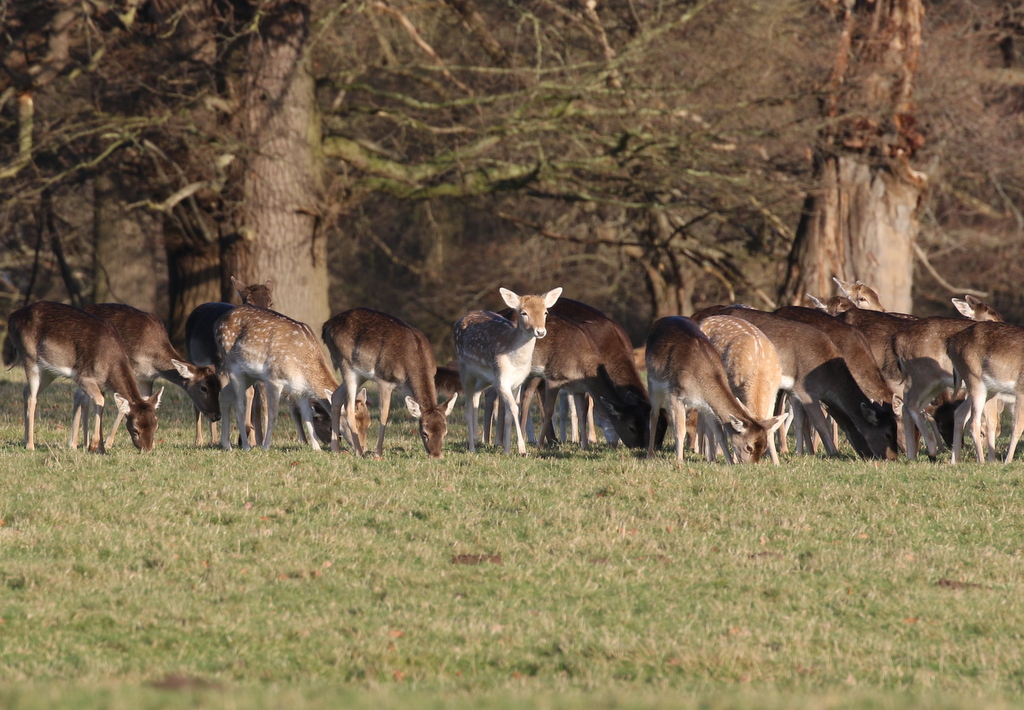
A couple of Common Buzzards were hanging in the air above the trees as we got back to the monument. A Great Spotted Woodpecker was hanging on the bag of peanuts as we got back to the houses by the gate. We still had a bit of spare time to play with, so we decided to see if we could catch up with some egrets. As we made our way west, a Red Kite was hanging in the air over the fields.
There were a few people looking out across the grazing marshes from the layby at Burnham Overy. They had seen a couple of Cattle Egrets and a Great White Egret, but none of them were visible now. Two White-fronted Geese were out in the field in front with a small group of Pinkfeet. We walked down along the verge and looked out towards the seawall. A Cattle Egret flew up but immediately dropped down again behind some thick reeds and brambles. It seemed for a minute like we might be frustrated.
Then we looked back towards the dunes to see a Great White Egret fly round. When it landed on the back edge of the furthest pool, we got it in the scope. It was a long way off and behind the reeds at first, but when it came out we could see its long yellow bill and long neck. When we turned our attention back to the grazing marsh below the seawall, the Cattle Egrets had reappeared – we could see seven of them out on the grass now.
We still had one thing we wanted to do, so we made our way back east and walked down the track to the edge of the saltmarsh. There were several Brown Hares in the fields, with three chasing each other round.
We had the roost to ourselves this evening. We didn’t have to wait long before the first Hen Harrier appeared, a ringtail. We watched it hunting, as it made its way further west until we lost sight of it. Then a smart grey male Hen Harrier flew in from the other direction. We watched as it flew low over the middle of the saltmarsh, before flying back to the far edge and then coming back in the opposite direction.
There were quite a few small groups of Brent Geese scattered around the saltmarsh. One of the groups contained a noticeably paler bird, a Pale-bellied Brent Goose with a creamy white belly. There were several groups of Golden Plover too, and one of them whirled round at one point, alternating white and gold as they turned in the low sunshine.
A Merlin came in high from the fields, away to our left. It dropped down and shot low over the ground before landing on a bush out in the middle of the saltmarsh. There was still some low sunlight and it was perfectly illuminated in the scope. While we were watching it, what was presumably the same male Hen Harrier ghosted across in front of it. And then we looked away to the west to see a second male hunting further back.
We could see the flocks of Knot swirling round over the beach beyond – perhaps the Peregrines were still out there hunting? A couple of hundred Pink-footed Geese were already sleeping out on the flats. A scan with the scope picked up a very distant Barn Owl hunting over in front of East Hills.
We were about to call it a day, when a Merlin suddenly shot up into the sky right in front of us. It was chasing a Meadow Pipit and we watched the two of them climb higher and higher, the pipit desperately trying to stay above the falcon. There followed an amazing dogfight for several minutes, the pipit twisting and turning, the Merlin very nearly catching it on a couple of occasions, but the pipit just managing to take evasive action at the last second, dropping suddenly, then turning up as the Merlin stooped and overshot. Eventually the two of them chased down into the bushes off to our right – we didn’t get to learn the ending, but it was exciting to watch.
If that wasn’t enough, two Hen Harriers then circled back in high over the middle of the saltmarsh, a male accompanied by a ringtail, the latter noticeably bigger, a female. We followed the male as he lost height and returned to hunting, disappearing off east.
The light was starting to go now and we couldn’t have hoped for a better end to the day. What a great day it had been too. It was time to head for home.
















